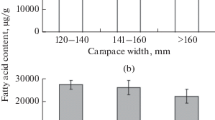Abstract
The relationship between intermoult duration (coloration), sex, size and seasonal variations in fatty acid (FA) profiles was studied in a population of shore crabs, Carcinus maenas, inhabiting the Isefjord, Denmark. For male shore crabs, the total hepatopancreas FA content was high in July and December (12.7 to 16.0 mg g−1 dry weight, dw) but lower in May and September (7.3 to 10.0 mg g−1). This indicates that male shore crabs are in relatively good condition before winter, when the crabs migrate off shore, but in relatively poor condition when they return to shallow waters during spring. The hepatopancreas FA content also decreased over the mating season. After the mating season the hepatopancreas FA content of males had decreased to approximately 60% of that prior to the mating season. Female shore crabs had significantly higher hepatopancreas FA levels than males in May (11.7 mg g−1 dw), September (12.6 mg g−1 dw) and December (17.9 mg g−1 dw) but lower levels in July (9.5 mg g−1 dw). This indicates that the spawning season is the most energy-demanding part of the female reproductive cycle. For all seasons, the hepatopancreas FA content of green shore crabs was significantly higher than that of red shore crabs. For both colour forms, the amount of polyunsaturated fatty acids (PUFAs) was significantly higher than that of saturated fatty acids (SAFAs) and monounsaturated fatty acids (MUFAs), with the relative proportion of PUFAs increasing when the total hepatopancreas FA content decreased. For both genders and colour forms, the most dominating SAFA was palmitic acid (16:0). Palmitoleic acid (16:1ω7), vaccenic acid (18:1ω7) and oleic acid (18:1ω9) were the three MUFAs found in highest concentrations. The most dominating PUFA was eicosapentaenoic acid (EPA, 20:5ω3). Docosahexaenoic acid (DHA, 22:6ω3) and arachidonic acid (AA, 20:4ω6) were also abundant in all samples. The results demonstrated that season, sex, size and intermoult duration all influence the amount of FAs present in the hepatopancreas of shore crabs.
Similar content being viewed by others
Author information
Authors and Affiliations
Additional information
Received: 23 September 1999 / Accepted: 29 April 2000
Rights and permissions
About this article
Cite this article
Styrishave, B., Andersen, O. Seasonal variations in hepatopancreas fatty acid profiles of two colour forms of shore crabs, Carcinus maenas . Marine Biology 137, 415–422 (2000). https://doi.org/10.1007/s002270000345
Issue Date:
DOI: https://doi.org/10.1007/s002270000345




